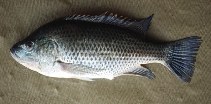http://www.fishbase.org/Summary/speciesSummary.php?genusname=Oreochromis&speciesname=hunteri ---> http://192.134.151.83/Summary/speciesSummary.php?genusname=Oreochromis&speciesname=hunteri
http://192.134.151.83/Summary/speciesSummary.php?genusname=Oreochromis&speciesname=hunteri ---> https://fishbase.mnhn.fr/Summary/speciesSummary.php?genusname=Oreochromis&speciesname=hunteri
https://fishbase.mnhn.fr/Summary/speciesSummary.php?genusname=Oreochromis&speciesname=hunteri ---> https://fishbase.mnhn.fr/summary/Oreochromis-hunteri.html
Oreochromis hunteri, Lake Chala tilapia

You can
sponsor
this page
Common name (e.g. trout)
Genus + Species (e.g. Gadus morhua)
-

-
About this page
-
Languages
-
User feedbacks
-
Citation
-
Uploads
-
Related species
-


 Lake Chala tilapia
Upload your
photos
and
videos
Lake Chala tilapia
Upload your
photos
and
videos
Pictures
|
Google image
 Oreochromis hunteri
Oreochromis hunteri
Picture by
de Vos, L.
Teleostei (teleosts) >
Cichliformes
(Cichlids, convict blennies) >
Cichlidae
(Cichlids) > Pseudocrenilabrinae
Etymology:
Oreochromis:
Latin, aurum = gold + Greek, chromis = a fish, perhaps a perch (Ref.
45335
)
.
More on author:
Günther
.
Environment: milieu / climate zone / depth range / distribution range
Ecology
Freshwater; benthopelagic. Tropical
Africa: endemic to Lake Chala in Kenya (Ref.
52331
) and Tanzania (Ref.
118630
).
Size / Weight / Age
Maturity: L
m
?
range ? - ? cm
Max length : 30.0 cm SL male/unsexed; (Ref.
4967
)
Dorsal
spines
(total): 16 - 17;
Dorsal
soft rays
(total): 11-13;
Anal
spines
: 3-4;
Anal
soft rays
: 10 - 16;
Vertebrae
: 31 - 34. Diagnosis: A large bodied tilapia, with a relatively large and forward-facing snout, body at least 2.8 times as long as deep (Ref.
4967
,
118638
). The species can be distinguished by following characters: teeth very small, in narrow bands; pharyngeal bone narrow, its width about 26% length of head, with fine teeth, crowded posteriorly, the blade equal to the median length of the toothed area in young, about 1.5 times as long in adults; pectoral fin usually less than 36% of standard length; anal spines III-IV; scales of chest and belly very small, in some individuals showing an abrupt transition from the flank scales for a short distance behind the pectoral-pelvic interspace; in some the dorsal scales may also be small; and caudal peduncle at least 1.3 times longer than deep (Ref.
2
,
4967
). Males characterised by an intricate melanin pattern on the head, flank scales that are darker towards posterior side, and a background light grey-blue colour; the dorsal region is darker than the ventral, and ripe males with dark pectoral, anal, caudal fins, while the dorsal fin is dark with orange margins; females with less contrasting colours, with flanks uniformly grey or olive, with a lighter ventral region (Ref.
118638
).
Only found in Lake Chala (Ref.
2
,
4967
,
36900
); several non-native tilapias are now established in this small lake as a result of stocking, and
Oreochromis hunteri
is apparently much less common than previously (Ref.
118638
). Sometimes swimming in shoals (Ref.
36900
,
55060
). It feeds on algae and debris off the bottom between the rocks near the shore (Ref.
2
,
55060
). A maternal mouthbrooder (Ref.
118638
). Fished in Lake Chala (Ref.
118638
). IUCN conservation status is critically endangered (Ref.
118638
).
Life cycle and mating behavior
Maturity
|
Reproduction
|
Spawning
|
Eggs
|
Fecundity
|
Larvae
A maternal mouthbrooder (Ref.
118638
).
Trewavas, E.
, 1983. Tilapiine fishes of the genera
Sarotherodon
,
Oreochromis
and
Danakilia
. British Mus. Nat. Hist., London, UK. 583 p. (Ref.
2
)
IUCN Red List Status (Ref.
130435
)
Critically Endangered (CR)
(B1ab(i,iii)); Date assessed:
22 June 2022
CITES
Not Evaluated
Not Evaluated
Threat to humans
Harmless
Human uses
FAO - Publication:
search
|
FishSource
|
More information
Countries
FAO areas
Ecosystems
Occurrences
Introductions
Stocks
Ecology
Diet
Food items
Food consumption
Ration
Common names
Synonyms
Metabolism
Predators
Ecotoxicology
Reproduction
Maturity
Spawning
Spawning aggregation
Fecundity
Eggs
Egg development
Age/Size
Growth
Length-weight
Length-length
Length-frequencies
Morphometrics
Morphology
Larvae
Larval dynamics
Recruitment
Abundance
BRUVS
References
Aquaculture
Aquaculture profile
Strains
Genetics
Electrophoreses
Heritability
Diseases
Processing
Nutrients
Mass conversion
Collaborators
Pictures
Stamps, Coins Misc.
Sounds
Ciguatera
Speed
Swim. type
Gill area
Otoliths
Brains
Vision
Tools
E-book
|
Field guide
|
Length-frequency wizard
|
Life-history tool
|
Point map
|
Classification Tree
|
Catch-MSY
|
Special reports
Check for Aquarium maintenance
|
Check for Species Fact Sheets
|
Check for Aquaculture Fact Sheets
Download XML
Summary page
|
Point data
|
Common names
|
Photos
Internet sources
AFORO (otoliths) |
Aquatic Commons
|
BHL
|
Cloffa
|
BOLDSystems
|
Websites from users
|
Check FishWatcher
|
CISTI
|
Catalog of Fishes
:
genus
,
species
|
DiscoverLife
|
ECOTOX
| FAO - Publication:
search
|
Faunafri
| Fishipedia |
Fishtrace
| GenBank:
genome
,
nucleotide
|
GloBI
|
Google Books
|
Google Scholar
|
Google
| IGFA World Record |
MitoFish
|
Otolith Atlas of Taiwan Fishes
|
PubMed
| Reef Life Survey | Socotra Atlas |
Tree of Life
| Wikipedia:
Go
,
Search
| World Records Freshwater Fishing |
Zoobank
|
Zoological Record
Estimates based on models
Phylogenetic diversity index (Ref.
82804
): PD
50
= 0.5000 [Uniqueness, from 0.5 = low to 2.0 = high].
Bayesian length-weight: a=0.01905 (0.00827 - 0.04391), b=3.01 (2.82 - 3.20), in cm total length, based on LWR estimates for this (Sub)family-body shape (Ref.
93245
).
Trophic level (Ref.
69278
): 2.0 ±0.00 se; based on food items.
Resilience (Ref.
120179
): Medium, minimum population doubling time 1.4 - 4.4 years (Preliminary K or Fecundity.).
Fishing Vulnerability (Ref.
59153
): Low to moderate vulnerability (27 of 100).
Back to Search
Random Species
Back to Top
Accessed through:
Not available
FishBase mirror site :
localhost
Page last modified by :
mrius-barile
- 20 July 2016
Fatal error
: Uncaught ArgumentCountError: Too few arguments to function checkEcotox(), 1 passed in /var/www/html/summary/speciessummary.php on line 2304 and exactly 3 expected in /var/www/html/includes/speciessummary.lib.php:2579 Stack trace: #0 /var/www/html/summary/speciessummary.php(2304): checkEcotox() #1 {main} thrown in
/var/www/html/includes/speciessummary.lib.php
on line
2579
|